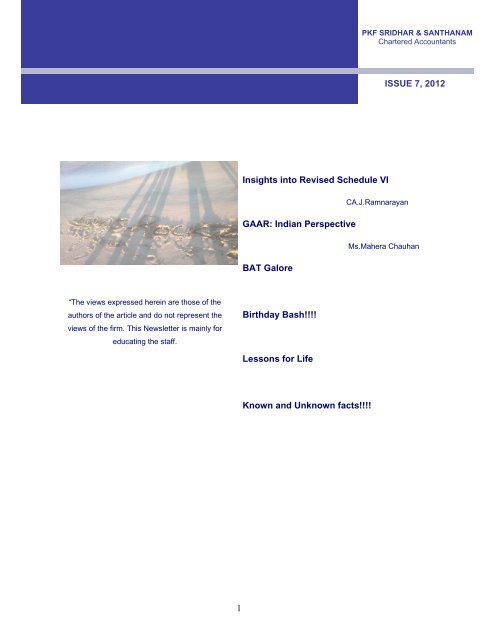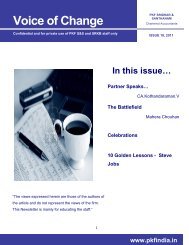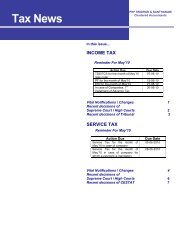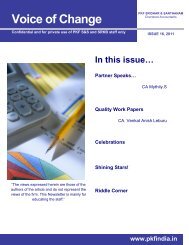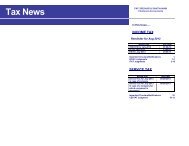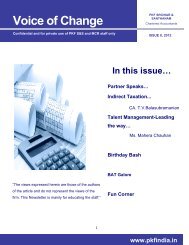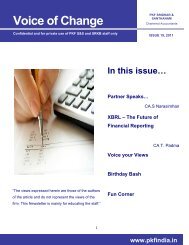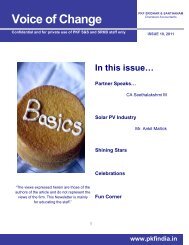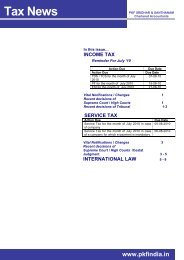Newsletter Issue No 7-15th July 2012 - PKF Sridhar & Santhanam
Newsletter Issue No 7-15th July 2012 - PKF Sridhar & Santhanam
Newsletter Issue No 7-15th July 2012 - PKF Sridhar & Santhanam
Create successful ePaper yourself
Turn your PDF publications into a flip-book with our unique Google optimized e-Paper software.
Voice of Change<br />
Confidential and for private use of <strong>PKF</strong> S&S and MCR staff only<br />
<strong>PKF</strong> SRIDHAR & SANTHANAM<br />
Chartered Accountants<br />
ISSUE 7, <strong>2012</strong><br />
Insights into Revised Schedule VI<br />
GAAR: Indian Perspective<br />
CA.J.Ramnarayan<br />
BAT Galore<br />
Ms.Mahera Chauhan<br />
“The views expressed herein are those of the<br />
authors of the article and do not represent the<br />
views of the firm. This <strong>Newsletter</strong> is mainly for<br />
educating the staff.<br />
Birthday Bash!!!!<br />
Lessons for Life<br />
Known and Unknown facts!!!!<br />
1<br />
www.pkfindia.in
<strong>PKF</strong><br />
SRIDHAR & SANTHANAM<br />
Chartered<br />
Accountantsccountants<br />
Insights into Revised Schedule VI<br />
CA.J. Ramnarayanan<br />
<strong>No</strong>w all the listed companies’<br />
statutory audits are over, it is<br />
time for small and medium<br />
companies’ audits to be taken<br />
up.<br />
Unlike big companies, in small<br />
and medium companies, the role<br />
of auditor in guiding the finance<br />
department and the management<br />
on revised schedule VI is much<br />
more. Through this article, I<br />
would like to share with you<br />
certain basic things on revised<br />
schedule VI which should be<br />
taken care at the time of<br />
finalising presentation of<br />
accounts.<br />
Accounting Standards prevail<br />
over Revised Schedule VI<br />
Wherever there is conflict in<br />
presentation requirements<br />
between Accounting Standards<br />
and the Revised Schedule VI,<br />
the requirements of the<br />
Accounting Standard would<br />
always prevail. Classic example<br />
is Cash & Cash equivalents.<br />
While there is no differentiation<br />
between cash equivalents (short<br />
term highly liquid investments<br />
generally of upto 3 months<br />
maturity readily convertible into<br />
known amount of cash) and<br />
others in revised schedule VI, AS<br />
3 Cash flow Statements require<br />
the same to be bifurcated and<br />
shown separately. ICAI GN<br />
suggests Cash and Bank<br />
balances as the overall heading<br />
in BS under which Cash and<br />
cash equivalents may be listed.<br />
Classification between current<br />
and non-current<br />
Though the revised schedule VI<br />
gives the definition of what is<br />
current and non-current, many<br />
times there will always be doubt<br />
on whether to classify a<br />
particular asset/liability as current<br />
or non-current. To overcome this<br />
situation, we shall keep a simple<br />
thumb rule. In the case of assets,<br />
we shall go by expectation and<br />
in the case of liability, we shall go<br />
by right to defer settlement.<br />
This has been further illustrated<br />
in the ICAI’s FAQ on revised<br />
schedule VI in Questions 27 &<br />
28.<br />
What will come under Trade<br />
Payables<br />
Though Ministry of Corporate<br />
Affairs (MCA) had come out with<br />
definition of trade payables,<br />
many times there is doubt in our<br />
mind on whether amount due to<br />
employees should be treated as<br />
trade payables as it is in the<br />
nature of services rendered. To<br />
resolve this doubt, ICAI has<br />
clearly spelt out that as dues to<br />
employees are in the nature of<br />
contractual obligations under<br />
employer - employee<br />
relationship, the same need not<br />
be considered as part of trade<br />
payables through FAQ no.9 on<br />
revised schedule VI.<br />
Classification of long term<br />
employee benefits into current<br />
and non-current<br />
2<br />
www.pkfindia.in
<strong>PKF</strong><br />
SRIDHAR & SANTHANAM<br />
Chartered Accountants<br />
As per Revised Schedule VI,<br />
even long term employee<br />
benefits like gratuity, pension,<br />
post-retirement medical benefit,<br />
etc. should also be bifurcated<br />
into current and non-current. To<br />
achieve this objective, we should<br />
take the help of actuaries and<br />
should insist for bifurcated<br />
amount to be mentioned in the<br />
actuarial valuation report itself.<br />
Presentation of taxes paid and<br />
provision made for taxation<br />
In pre-revised schedule VI era,<br />
people used to net-off cumulative<br />
taxes paid for different<br />
assessment years against the<br />
cumulative provision for tax<br />
made in the books and the<br />
resultant figure is either shown<br />
under current assets or current<br />
liabilities as the case may be. But<br />
under revised schedule VI, one<br />
has to bifurcate them as well into<br />
current and non-current. To<br />
facilitate the same, we should<br />
ask our clients to provide us with<br />
assessment year wise provisions<br />
made & taxes paid and should<br />
make the netting off assessment<br />
year-wise and present the<br />
assessment year-wise balances<br />
under non-current assets (unless<br />
say a refund order is received<br />
and receipt is expected) or<br />
current liabilities as the case may<br />
be.<br />
Capital Advances and Capital<br />
Work-in-progress<br />
Under revised schedule VI, one<br />
has to bifurcate between<br />
advances paid for projects till<br />
date and the work completed till<br />
date. To distinguish between<br />
advances and payments made<br />
against work completed till date,<br />
we have to review each & every<br />
contract at the time of audit as<br />
well as the nature of contract.<br />
For instance, all payments made<br />
in the case of turnkey contracts<br />
will have to be classified under<br />
capital advances only till the time<br />
of completion (i.e. capitalisation)<br />
of the project.<br />
Capital advances need to be<br />
disclosed as non-current assets<br />
even if they are received in Apr<br />
next.<br />
Classification of trade<br />
receivables based on due<br />
dates<br />
Another significant change made<br />
in revised schedule VI is the<br />
classification of trade receivables<br />
into less than & more than 6<br />
months based on due dates.<br />
Earlier it was based on the date<br />
of invoice. At the time of audit,<br />
one has to go through each and<br />
every sale order terms to identify<br />
the credit period offered and<br />
accordingly classify the trade<br />
receivables into less than 6<br />
months, more than 6 months and<br />
more than 12 months. For<br />
practical reasons you may also<br />
adopt for each uniform group of<br />
customers an average credit<br />
period, if there are numerous<br />
customers.<br />
3<br />
www.pkfindia.in
<strong>PKF</strong><br />
SRIDHAR & SANTHANAM<br />
Chartered Accountants<br />
Other Operating Income and<br />
Other Income<br />
ICAI FAQ states that whether an<br />
item should be classified as<br />
“other operating revenue” or<br />
“other income” is a matter of<br />
judgment and requires<br />
consideration of specific facts. In<br />
a number of cases, the dividing<br />
line between these two items<br />
may be very blurred. It requires<br />
an exercise of significant<br />
judgment. Hence, at the time of<br />
audit, decision on classification<br />
of income should be taken based<br />
on the nature of business<br />
undertaken by the client and past<br />
business practices.<br />
Interest paid towards shortfall<br />
in advance tax payments &<br />
Wealth tax<br />
As per revised schedule VI, all<br />
such interest liabilities need to be<br />
classified under finance costs<br />
and not under current-tax or<br />
other expenses. Also wealth tax<br />
payable by the company has to<br />
be included now only under rates<br />
& taxes and not under current tax<br />
or any other head.<br />
Exceptional and Extra-ordinary<br />
items<br />
Also under revised schedule VI,<br />
one has to bifurcate and present<br />
exceptional and extra-ordinary<br />
items separately. Exceptional<br />
items are those items of income<br />
and expense within profit or loss<br />
from ordinary activities, are of<br />
such size, nature or incidence<br />
that their disclosure is relevant to<br />
explain the performance of the<br />
enterprise for the period.<br />
(Example: Huge Profit on Sale of<br />
fixed assets) Extra-ordinary<br />
items are income or expenses<br />
that arise from events or<br />
transactions that are clearly<br />
distinct from the ordinary<br />
activities of the enterprise and,<br />
therefore, are not expected to<br />
recur frequently or regularly.<br />
(Example: loss by earthquake<br />
/tsunami etc) One has to classify<br />
the items, at the time of audit, in<br />
the lines of the above definitions,<br />
and present accordingly in the<br />
financials.<br />
Disclaimer<br />
This article brings out only the<br />
major features of revised<br />
schedule VI which need to be<br />
taken care at the time of audit of<br />
small and medium enterprises.<br />
One should always refer to<br />
revised schedule VI issued by<br />
MCA and the guidance note &<br />
FAQ issued by ICAI at the time<br />
of audit to ensure compliance<br />
with all presentation<br />
requirements of revised schedule<br />
VI.<br />
Happy Auditing ☺<br />
4<br />
www.pkfindia.in
<strong>PKF</strong><br />
SRIDHAR & SANTHANAM<br />
Chartered Accountants<br />
GAAR: Indian Perspective<br />
Ms.Mahera Chauhan<br />
A constant debate has been<br />
raging over the issue of tax<br />
avoidance. Over the years, the<br />
term ‘tax avoidance’ has come<br />
to be understood as arranging<br />
affairs with the main object or<br />
purpose of obtaining tax<br />
advantage while prima facie<br />
fully intending to comply with<br />
the law in such respect<br />
Globally, tax avoidance has<br />
been recognized as an area of<br />
concern and several countries<br />
have expressed concern over<br />
tax evasion and avoidance.<br />
This is evident from the fact that<br />
either nations are legislating the<br />
doctrine of General Anti-<br />
Avoidance Regulations in their<br />
tax code or strengthening their<br />
existing code.<br />
The GAAR Mechanics:<br />
In India, the proposed Direct<br />
Tax Code 2010 (DTC 2010 or<br />
Code) seeks to address the<br />
issues relating to tax avoidance<br />
and evasion by bringing in<br />
General Anti-Avoidance Rules<br />
(GAAR) in addition to various<br />
transaction-specific Special<br />
Anti-Avoidance provisions.<br />
In a nutshell the whole GAAR<br />
scheme revolves around the<br />
5<br />
www.pkfindia.in
<strong>PKF</strong><br />
SRIDHAR & SANTHANAM<br />
Chartered Accountants<br />
question of whether an<br />
arrangement qualifies as what<br />
is termed an ‘impermissible<br />
avoidance arrangement’.<br />
This term in turn comprises of<br />
two distinct components - the<br />
main purpose test and the<br />
specified conditions test. If<br />
upon application of the above<br />
tests, an arrangement qualifies<br />
as an ‘impermissible avoidance<br />
arrangement’, the Finance Bill<br />
proposes to empower the tax<br />
authorities with wide ranging<br />
powers to determine its<br />
consequences, including one or<br />
more of the six specified<br />
consequences appearing in the<br />
above chart.<br />
It has been introduced in India<br />
due to VODAFONE case ruling<br />
in favour of this company by the<br />
Supreme Court. The new rules<br />
were expected to come into<br />
effect from 01 April, <strong>2012</strong>.<br />
The scope of the Indian GAAR<br />
is wide reaching as it seeks to<br />
cover within its ambit nearly all<br />
transactions and structures<br />
which have any element of tax<br />
planning imbedded. The<br />
justification for such an “all<br />
encompassing” provision<br />
probably lies in the fact that<br />
nations across the world take a<br />
conscious decision to<br />
implement GAAR in their<br />
statutes since it is not feasible<br />
for tax legislation to enact<br />
specific anti avoidance rules for<br />
all forms of tax avoidance<br />
transactions.<br />
Quick Facts about the proposed GAAR in India:<br />
— The General Anti<br />
entirely from the<br />
Avoidance Rule, or<br />
taxpayer and shift it to<br />
GAAR, was proposed<br />
the<br />
revenue<br />
in mid-March as part of<br />
departments.<br />
the budget for fiscal<br />
— A local or foreign<br />
2013.<br />
taxpayer will also be<br />
— GAAR aims to target<br />
able to approach<br />
tax evaders, partly by<br />
authorities in advance<br />
stopping Indian<br />
for a ruling on their<br />
companies and<br />
potential tax liabilities,<br />
investors from routing<br />
Mukherjee proposed.<br />
investments through<br />
— An independent<br />
Mauritius or other tax<br />
havens for the sole<br />
member would be in<br />
the GAAR approving<br />
purpose of avoiding<br />
panel, while one<br />
taxes.<br />
— Proposes to remove<br />
member would be an<br />
officer of the level of<br />
the onus of proof<br />
Joint Secretary, or<br />
above, from the<br />
Ministry of Law.<br />
— A committee would be<br />
constituted under the<br />
Chairmanship of the<br />
Director General of<br />
Income Tax, with the<br />
task of providing<br />
recommendations by<br />
May 31 for formulating<br />
the rules and guidelines<br />
to implement GAAR<br />
provisions.<br />
— On the proposed<br />
retrospective<br />
amendment in tax<br />
rules, Mukherjee said<br />
the changes will not<br />
6<br />
www.pkfindia.in
<strong>PKF</strong><br />
SRIDHAR & SANTHANAM<br />
Chartered Accountants<br />
— Override the provisions<br />
of<br />
double-tax<br />
avoidance treaties India<br />
has with 82 countries.<br />
— The proposed<br />
retrospective changes<br />
in tax rules will not be<br />
used to reopen cases<br />
where assessment<br />
orders have already<br />
been finalised.<br />
— Ministry of Finance<br />
proposes to reduce<br />
The Countdown begins…<br />
India will delay introduction of<br />
GAAR by one year until fiscal<br />
2013/14. Finance Minister also<br />
told Parliament that the burden<br />
of proving tax evasion will lie<br />
with the authorities rather than<br />
with overseas investors.<br />
Over the past few weeks, there<br />
has been a lot of discussion on<br />
general anti-avoidance rule<br />
(GAAR) that has been<br />
proposed in the recent Union<br />
budget.<br />
Taxpayers, domestic and<br />
foreign, will witness a paradigm<br />
shift in the empowerment and<br />
approach of tax authorities in<br />
India towards taxation of<br />
— long-term capital gains<br />
tax on private equity<br />
firms on the sale of<br />
unlisted securities to<br />
10%, from 20%<br />
currently, and bring the<br />
tax rate in line with<br />
what is charged from<br />
foreign portfolio<br />
investors.<br />
— Also, proposed to cut<br />
the withholding tax to<br />
5% from 20% currently<br />
transactions, structures and<br />
arrangements.<br />
The introduction of GAAR will<br />
legislatively empower the tax<br />
authorities to intervene in<br />
circumstances where they<br />
allege that the primary motive<br />
of a particular transaction or<br />
arrangement is to obtain a tax<br />
advantage.<br />
More importantly, the onus is<br />
on the tax payer to prove that<br />
the transaction was not driven<br />
by tax consideration.<br />
GAAR is aimed at curbing tax<br />
avoidance by say, structuring a<br />
business or effecting a<br />
transaction so as to minimise<br />
the liability. A shining example<br />
— on funding through<br />
foreign loans for "all<br />
businesses."<br />
— The Finance Minister<br />
proposed to extend the<br />
tax exemption on longterm<br />
capital gains<br />
related to the sale of<br />
unlisted securities in an<br />
initial public offering.<br />
The levy of the<br />
Securities Transaction<br />
Tax would be levied at<br />
the rate of 0.2% on the<br />
sales of unlisted<br />
securities.<br />
would be the creation of a shellholding<br />
company in a taxfriendly<br />
country like Mauritius to<br />
invest in India. GAAR<br />
empowers tax authorities to<br />
separate transactions aimed at<br />
avoiding tax from the ones<br />
driven by commercial<br />
consideration.<br />
As of March 16, <strong>2012</strong>, FIIs had<br />
assets under custody of more<br />
than 10 trillion (over $200<br />
billion), representing 17% of the<br />
capitalisation of Indian<br />
securities markets, or as much<br />
as 40% of the free-float on the<br />
Indian exchanges.<br />
India's economic success story<br />
is one factor that draws global<br />
7<br />
www.pkfindia.in
<strong>PKF</strong><br />
SRIDHAR & SANTHANAM<br />
Chartered Accountants<br />
capital to its shores. Ease of<br />
market access and a<br />
transparent and predictable tax<br />
system is another. The tax<br />
uncertainty now anticipated<br />
creates significant risk that<br />
these global funds will choose<br />
to avoid the Indian capital<br />
markets altogether and redirect<br />
their resources to other<br />
opportunities.<br />
The government says the move<br />
is not aimed at maximising tax<br />
revenues but plugging tax<br />
leakages.<br />
Conclusion<br />
As taxpayers and investors<br />
gear up to meet the GAAR<br />
challenge post <strong>2012</strong>, they look<br />
forward to gaining some<br />
administrative guidance being<br />
issued providing safe harbour<br />
for invocation of GAAR, as well<br />
as providing for standards of<br />
documentation which may be<br />
required to be maintained by<br />
taxpayers and investors.<br />
It is hoped that tax authorities<br />
will refrain from indulging in<br />
misuse the power provided<br />
under this provision. Experts<br />
recommended that the<br />
Government should adopt the<br />
best international practices to<br />
combat misuse of the<br />
provisions of GAAR by tax<br />
authorities particularly on<br />
burden of proof which presently<br />
is on the tax payer.<br />
One such suggestion could be<br />
the setting up of a high level<br />
Committee which needs to<br />
approve<br />
each<br />
transaction/structure in which<br />
GAAR is proposed to be<br />
invoked, as has been done in<br />
Canada.<br />
The success of GAAR lies in its<br />
judicious, selective and<br />
sensible implementation. In the<br />
Indian context, considering the<br />
aggression of the of tax<br />
administration the introduction<br />
of GAAR may be worrisome to<br />
the tax payers and investors<br />
unless implemented in the<br />
balanced manner with<br />
adequate safeguards for<br />
protecting the taxpaying<br />
community.<br />
8<br />
www.pkfindia.in
<strong>PKF</strong><br />
SRIDHAR & SANTHANAM<br />
Chartered Accountants<br />
Congratulations to Prakasam for handling a special audit extraordinarily well.<br />
9<br />
www.pkfindia.in
<strong>PKF</strong><br />
SRIDHAR & SANTHANAM<br />
Chartered Accountants<br />
Birthday Bash!!!!<br />
Name DOB Place<br />
Sukanya Thyagarajan 19-Jul Bangalore<br />
Bindiya Sanjay Makhija 22-Jul Hyderabad<br />
Nidhi Bharti 23-Jul Mumbai<br />
Meghana Purohit 24-Jul Bangalore<br />
Divya B 25-Jul Chennai<br />
Prakasam.P 26-Jul Chennai<br />
Ali Asgar Bohra 28-Jul Mumbai<br />
Perla Sudheer 29-Jul Bangalore<br />
10<br />
www.pkfindia.in
<strong>PKF</strong><br />
SRIDHAR & SANTHANAM<br />
Chartered Accountants<br />
Lessons for Life<br />
11<br />
www.pkfindia.in
<strong>PKF</strong><br />
SRIDHAR & SANTHANAM<br />
Chartered Accountants<br />
Known and Unknown FACTS!!!!!<br />
How many of these do you know<br />
1. MOPED is the short term for 'Motorized Pedaling'.<br />
2. POP MUSIC is 'Popular Music' shortened.<br />
3. BUS is the short term for 'Omnibus' that means everybody.<br />
4. FORTNIGHT comes from 'Fourteen Nights' (Two Weeks).<br />
5. DRAWING ROOM was actually a 'withdrawing room' where people withdrew after Dinner. Later<br />
the prefix 'with' was dropped..<br />
6. AG-MARK, which some products bear, stems from 'Agricultural Marketing'.<br />
7. JOURNAL is a diary that tells about 'Journey for a day' during each Day's business.<br />
8. TIPS come from 'To Insure Prompt Service'. In olden days to get Prompt service from servants in<br />
an inn, travellers used to drop coins in a Box on which was written 'To Insure Prompt Service'. This<br />
gave rise to the custom of Tips.<br />
9. JEEP is a vehicle with unique Gear system. It was invented during World War II (1939-1945). It<br />
was named 'General Purpose Vehicle (GP)'.GP was changed into JEEP later.<br />
10. Coca-Cola was originally green.<br />
11. The name of all the continents end with the same letter that they start with.<br />
12. The strongest muscle in the body is the tongue.<br />
13. TYPEWRITER is the longest word that can be made using the letters only on one row 1 of the<br />
keyboard.<br />
14. You can't kill yourself by holding your breath.<br />
15. People say "Bless you" when you sneeze because when you sneeze, your heart stops for a<br />
millisecond.<br />
16. The "sixth sick sheik's sixth sheep's sick" is said to be the toughest tongue twister in the<br />
English language.<br />
12<br />
www.pkfindia.in
<strong>PKF</strong><br />
SRIDHAR & SANTHANAM<br />
Chartered Accountants<br />
17. If you sneeze too hard, you can fracture a rib. If you try to suppress a sneeze, you can rupture a<br />
blood vessel in your head or neck and die.<br />
18. What do bullet proof vests, fire escapes, windshield wipers and laser printers all have in common<br />
Ans. - All invented by women.<br />
19. A snail can sleep for three years.<br />
20. On average, people fear spiders more than they do death.<br />
21. Shakespeare invented the word 'assassination' and 'bump'.<br />
22. The ant always falls over on its right side when intoxicated.<br />
23. Rats multiply so quickly that in 18 months, two rats could have over million descendants.<br />
24. Wearing headphones for just an hour will increase the bacteria in your ear by 700 times.<br />
25. Like fingerprints, everyone's tongue print is different.<br />
13<br />
www.pkfindia.in
<strong>PKF</strong><br />
SRIDHAR & SANTHANAM<br />
Chartered Accountants<br />
The Editorial Committee:<br />
Chief Editor<br />
• S Ramakrishnan<br />
The Team<br />
• Janani Vijayakumar<br />
• Mahera Chauhan<br />
• Harini Vijayakumar<br />
• Nithya Rajagopalan<br />
• Charanya Sathyamoorthy<br />
• Vinayasree Menon<br />
• Priyanka Pattabiraman<br />
14<br />
www.pkfindia.in
15<br />
www.pkfindia.in


